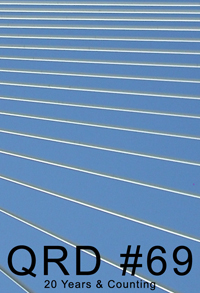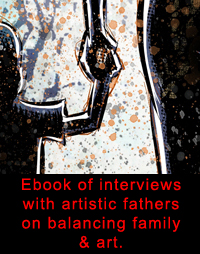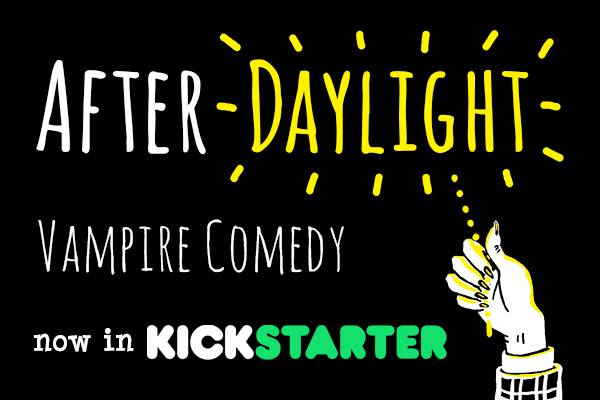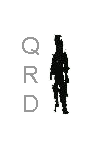
 |
| about
this issue Feature Interviews: Nick Marino babysue Guitarist Interviews: Trey McManus Ryan Potter Jonathon Trevillien Comic Creator Interviews: Sarah Roark Comic Shop Interviews: Legends Comics & Books Modern Myths Third Eye Retrospective QRD - Martin Newman |
 |
 |
 |
 |
 |
 |
 |
|
|
                                        |
October 2014

City: San Francisco
Comics: After Daylight - Vampire Comedy
Websites: http://www.afterdaylight.com
QRD – How old were you when you first got into comics & did you always stick with them or did you come back to them?
Sarah – I was actually much more intensely into newspaper comics when I was a kid. In elementary & middle school it was Doonesbury, Bloom County, Garfield, For Better or for Worse, Far Side, later on Dykes to Watch Out For & Calvin & Hobbes. They were a big influence. I also liked the Pinis’ approach to comics in Elfquest & the Worleys’ in Omaha the Cat Dancer. Although I liked some of the X-Men stuff, I didn’t get deep into comic books until I discovered Neil Gaiman, & after that I was a pretty permanent addition to the fandom.
QRD – What was the first comic book you ever bought?
Sarah – I don’t remember if I bought that B&W Elfquest #1. I shoulda!! I think it was probably either a vintage Superman or Evil Ed #1.
QRD – How old were you when you put out your first comic?
Sarah – After Daylight is the first comic I’ve actually put out as in published, so, uh...39? I was drawing comics for my own & friends’ pleasure before that, but not on a serious ongoing basis.
QRD – What decade do you think produced the best comics?
Sarah – I happen to be a fan of the Neil Gaiman renaissance in the 90s, but there was also some not-so-good stuff that came out of that era, so it may just be that that was the decade I started paying more attention. :-)
QRD – Why comics instead of just writing or drawing?
Sarah – I’ve always told stories, but they’ve always had a very strong visual component to them. I’ve also always drawn, although my drawing was more on the hobby level than my writing. I still love writing prose, but I do find it extremely satisfying to have those moments where I can put across a feeling or a plot twist or a whatever in one panel that would have taken a couple pages in prose fiction. The words & the pictures each have things they can do that the other can’t & put together they’re more than the sum of the parts.
QRD – Do you see mini-comics & indie comics as paths to mainstream comics or as their own unique media?
Sarah – For me, it’s its own thing...we all owe mainstream comics a lot, but my stories aren’t on the kind of subjects where they really *have* to be big-publisher produced to have a proper home. I am always glad when I see the mainstream publishers expand their repertoire, though, & I think that in addition to being awesome on their own, indie comics, minicomics, & other alternative comics put pressure on the big guys to up their game.
QRD – How many copies of your comic do you print in your first run?
Sarah – I’ll tell you after the Kickstarter. :-) I have been web distributed up to now, so that’s the infinite-monkeys, infinite-copies side of things.
QRD – How much do you think comics should cost?
Sarah – Oo. Well, it really depends, but I think they definitely always need to be at a price point where the creators make a decent per-page, unless they’re working on a business model that gets a fair share of money to the creator in other ways. Basically nobody should be stiffed of their share & the publisher should be taking most of the financial risk. So then the price point will fluctuate depending on the format, the length & frequency, the size of the print run, etc.
QRD – How many books do you produce a year & how many would you like to?
Sarah – It’s taken me not quite two years to get the first 100-page arc done. If I could ever get that down to more like a year I’d be very happy, but I don’t know if that’s possible with the kind of hand-shading I do.
QRD – Do you think stories should be serialized or delivered as complete works?
Sarah – That absolutely depends on the story itself. I don’t have a dogma on the subject.
QRD – How are comic strips different than comic books & which medium do you prefer?
Sarah – Well, comic strips have to condense all their beats. They can still tell excellent long-form stories -- Doonesbury & Dykes to Watch Out For proved that a long time ago. But each strip has to set up, follow through & round off satisfyingly. That’s tough, but I think the people who are masters of it have kind of a superpower of getting right to the point. On the other hand, some stories really benefit from more luxuriating -- those are the ones that need a book to spread out in.
QRD – How long is it from when you start a comic until it’s printed?
Sarah – Usually a week per page & I release a page a week when a volume is running. That was the case for Vol. 1 & that’ll be how it is when Vol. 2 starts up.
QRD – What do you do better with your comics now than when you first started?
Sarah – Anatomy, I think at least somewhat. “Camera” angles.
QRD – Do you do thumbnails?
Sarah – Only when I distribute on sites that ask for them.
QRD – At what size do you draw?
Sarah – I draw on a fairly standard 10”x15” “safe area” on an 11”x17”.
QRD – What kind of pens do you use?
Sarah – I actually ink digitally now, but my hand-shading is done with grayscale Copic markers.
QRD – What does your workstation look like?
Sarah – A damned mess, usually.
QRD – At what point in the artistic process do you work digitally?
Sarah – I do most of it digitally now except the hand-shading. Sometimes I’ll still do hand pencilling.
QRD – What do you think of digital comics & webcomics?
Sarah – I think many of them are awesome & that they are an entirely legitimate addition to the canon.
QRD – Do you prefer working in color or black & white?
Sarah – Color scares me. :-) I feel more comfortable right now with value than color, although I hope that’ll change as I improve.
QRD – How many different people should work on a comic & what should their jobs be?
Sarah – I don’t really feel a “should” in there, although there are dangers in creating by too large a committee. Both solo creators & writer/artist/letterer/colorist collabs can make awesome stuff, & few people don’t benefit from skilled editing. I have no problem with the publishing-house model & great stuff has come out of it; by the same token, I’m grateful that technology has made being an auteur so much more viable.
QRD – How do you find collaborators?
Sarah – It’s tough! Especially if you want to be the writing end of it & not the drawing end. That’s how I wound up drawing my own comic. Needs must when the devil drives. :-) The only advice I can give on that front is that making connections takes time & has to grow organically, you can only force it so much. Especially if you don’t have a big paycheck to wave.
QRD – How tight do you think a script should be as far as telling the artist what to draw?
Sarah – Another matter on which I don’t care about right or wrong, I care about what works. Some artists are going to prefer a lot of flexibility & others will flourish with a script that really gives them the info they need to get the story beats. As long as it’s the right writer with the right artist, I’m good.
QRD – Do you think it’s important to have a full story arc completely written before starting to draw?
Sarah – I think having at least the outline of an arc is important, but I don’t think it necessarily has to be planned to the last iota. A lot of those details WILL change as you get into the project & start seeing what works & what doesn’t, but if it helps you to draw up a detailed plan in advance even knowing it won’t survive contact with the enemy, go right ahead. Just don’t spend five years planning before you ever draw a line -- if it gets that bad you’re probably dealing with a case of stage fright you need to get past!
QRD – What comic book person would you be most flattered to be compared to?
Sarah – Alison Bechdel.
QRD – What do your friends & family think of your comics?
Sarah – A lot of them seem to like it. A few clearly love it. Some, they’re not into this genre, so they don’t really care; but almost all of them are at least supportive of what I do. That’s probably about as much as any of us can expect.
QRD – What do you think of superheroes?
Sarah – I think superheroes are what this culture calls its demigods & culture heroes. It’s an ancient genre in a new form. I think it’s very, very good for telling certain kinds of stories & people are figuring out exciting new ways to stretch out the medium, but comics also shouldn’t be all spandex & superpowers.
QRD – Marvel or DC?
Sarah – Eeeeehhhhh...I don’t really do religious wars. Maybe Marvel by a certain margin, but honestly, I judge by the individual comic line not the publisher.
QRD – What comic characters other than your own would you like to work with?
Sarah – It might be fun to play with the Girl Genius or the Gloom Cookie characters...or on a White Wolf/Onyx Path comic.
QRD – Ideally would you self-publish?
Sarah – I am attempting that even as we speak!
QRD – What conventions do you try to attend & why?
Sarah – I am thinking I will need to start out with smaller local conventions & then branch out as I discover what kind of con is most likely to have potential fans of my work at it. It may not be just comic cons, either. General fandom cons or horror cons are also a possibility.
QRD – How do you feel about doing work for anthologies?
Sarah – I would do it if I had time, if the compensation was fair & if the people were the right folks.
QRD – What do you do to promote your books?
Sarah – Most of my promo is on the site itself & in social media, but I also spend latte money on Project Wonderful ads. Once the dead-tree book is printed I will also be using cons as a vehicle.
QRD – Do you think your comics are well suited to comic shops or would sell better elsewhere?
Sarah – The FLCS is a hallowed institution that can really serve the community greatly when it’s done right & when they are supported in turn. On the other hand, I don’t see why comics shouldn’t also be sold anywhere people might like to buy them.
QRD – What other medium would you like to see some of your comics made into (television, film, games, action figures, etc.)?
Sarah – I would love to see some test animation shorts of it to see if it works well in animated form! Or even as a motion comic.
QRD – Do you consider yourself a comic collector or a comic reader or both?
Sarah – Reader. For the most part. There are a few babies I have & love, but I don’t have a lot of the collector spirit in me.
QRD – What do you see as the most viable mediums for comics distribution 10 years from now?
Sarah – I think there is certainly a trend to greater digital distribution that’s not going to stop, but right now it’s still optimized for print/prose. We need formats where the art of the comics medium has the room it needs to breathe & play out its story beats satisfyingly.
QRD – What would you like to see more people doing with comics?
Sarah – Everything. All the things. The more things people are doing, the more great ideas burble into the heads of people who will become the next creative geniuses & the more awesome things get in all aspects of not only pop culture, but culture culture.
QRD – Anything else?
Sarah – Not really, I think you basically covered it! But I would like everybody who’s reading this from 10/20/14 to 11/19/14 to consider visiting my Volume 1 Kickstarter at https://www.kickstarter.com/projects/237621404/after-daylight-vampire-comedy-volume-1. & if you missed the Kickstarter, come by the comic website & there should be plentiful links for picking up a deluxe softcover or digital copy of the book. Also, free web-size updates from Volume 2 will start up soon!
